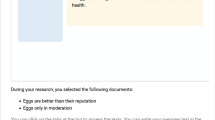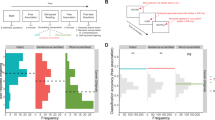Abstract
Three experiments investigated the role of source information (i.e., who said what) in readers’ comprehension of short informational texts. Based on the Discrepancy-Induced Source Comprehension assumption (Braasch, Rouet, Vibert, & Britt, 2012), we hypothesized that readers would be more likely to make use of source information when summarizing stories that included discrepant statements. Readers would also memorize source information more accurately. Experiments 1 and 2 found that American and French college students were more likely to refer to source information when they summarized news reports containing discrepant assertions. A detailed content analysis of the summaries also indicated that students use hedging and several other tactics to resolve contradictions. Experiment 3 replicated Braasch et al.’s finding that sources of discrepant stories were more likely to be recalled than sources of consistent stories. Experiment 3 also extended these findings using longer texts and a different reading task. Altogether the data support the Documents Model framework of multiple source comprehension.
Similar content being viewed by others
References
Albrecht, J. E., & O’Brien, E. J. (1993). Updating a mental model: Maintaining both local and global coherence. Journal of Experimental Psychology: Learning, Memory, and Cognition, 19, 1061–1070.
Baker, L., & Anderson, R. I. (1982). Effects of inconsistent information on text processing: Evidence for comprehension monitoring. Reading Research Quarterly, 17, 281–294.
Braasch, J. L. G., Rouet, J.-F., Vibert, N., & Britt, M. A. (2012). Readers’ use of source information in text comprehension. Memory and Cognition, 40, 450–465. doi:10.3758/s13421-011-0160-6.
Bråten, I., Strømsø, H., Britt, M. A., & Rouet, J.-F. (2011). The role of epistemic beliefs in the comprehension of multiple expository texts: Towards an integrated model. Educational Psychologist, 46, 48–70.
Bråten, I., Strømsø, H., & Salmerón, L. (2010). Trust and mistrust when students read multiple information sources about climate change. Learning and Instruction, 21, 180–192.
Britt, M. A., & Aglinskas, C. (2002). Improving students’ ability to identify and use source information. Cognition and Instruction, 20, 485–522.
Britt, M. A., Perfetti, C. A., Sandak, R., & Rouet, J. F. (1999). Content integration and source separation in learning from multiple texts. In S. R. Goldman, A. C. Graesser, & P. van den Broek (Eds.), Narrative comprehension, causality, and coherence: Essays in honor of Tom Trabasso (pp. 209–233). Mahwah, NJ: Lawrence Erlbaum Associates.
Brown, A. L., & Day, J. D. (1983). Macrorules for summarizing texts: The development of expertise. Journal of Verbal Learning and Verbal Behavior, 22, 1–14.
de Pereyra, G., Britt, M. A., Braasch, J. L. G., & Rouet, J. F. (2014). Reader’s memory for information sources in simple news stories: Effects of text and task features. Journal of Cognitive Psychology, 24(2), 187–204. doi:10.1080/20445911.2013.879152.
Goldman, S. R. (2004). Cognitive aspects of constructing meaning through and across multiple texts. In N. Shuart-Ferris & D. M. Bloome (Eds.), Uses of intertextuality in classroom and educational research (pp. 313–347). Greenwich, CT: Information Age Publishing.
Goldman, S. R., Saul, E. U., & Coté, N. (1995). Paragraphing, reader, and task effects on discourse comprehension. Discourse Processes, 20, 273–305.
Graesser, A. C., Bowers, C., Olde, B., & Pomeroy, V. (1999). Who said what? Source memory for narrator and character agents in literary short stories. Journal of Educational Psychology, 91, 284–300.
Hakala, C. M., & O’Brien, E. J. (1995). Strategies for resolving coherence breaks in reading. Discourse Processes, 20, 167–185.
Johnson, H. M., & Seifert, C. M. (1999). Modifying mental representations: Comprehending corrections. In H. van Oostendorp & S. Goldman (Eds.), The construction of mental representations during reading (pp. 303–318). Mahwah, NJ: Erlbaum.
Kammerer, Y., Bråten, I., Gerjets, P., & Strømsø, H. I. (2013). The role of Internet-specific epistemic beliefs in laypersons’ source evaluations and decisions during Web search on a medical issue. Computers in Human Behavior, 29, 1193–1203.
Keck, D., Kammerer, Y., & Starauschek, E. (2015). Reading science texts online: Does source information influence the identification of contradictions within texts? Computers & Education, 82, 442–449.
Kim, H. J. J., & Millis, K. (2006). The influence of sourcing and relatedness on event integration. Discourse Processes, 41, 51–65.
Kintsch, W. (1998). Comprehension: A paradigm for cognition. Cambridge, MA: Cambridge University Press.
Long, D. L., & Spooner, A. (2010). Placing a text in context. Psychonomic Bulletin & Review, 17, 237–242.
Lorch, R. F, Jr, Lorch, E. P., Ritchey, K., McGovern, L., & Coleman, D. (2001). Effects of headings on text sumarization. Contemporary Educational Psychology, 26, 171–191.
McCrudden, M. T., & Schraw, G. (2007). Relevance and goal-focusing in text processing. Educational Psychology Review, 19, 113–139.
O’Brien, E. J., Rizzella, M. L., Albrecht, J. E., & Halleran, J. G. (1998). Updating a situation model: A resonance text processing view. Journal of Experimental Psychology: Learning, Memory, and Cognition, 24, 1200–1210.
Perfetti, C. A., Rouet, J.-F., & Britt, M. A. (1999). Towards a theory of documents representation. In H. van Oostendorp & S. Goldman (Eds.), The construction of mental representations during reading (pp. 99–122). Mahwah, NJ: Erlbaum.
Rapp, D. N., & Kendeou, P. (2007). Revising what readers know: Updating text representations during narrative comprehension. Memory and Cognition, 36, 479–494.
Rouet, J.-F. (2006). The skills of document use: From text comprehension to web-based learning. Mahwah, NJ: Erlbaum.
Rouet, J.-F., & Britt, M. A. (2014). Learning from multiple documents. In R. E. Mayer (Ed.), Cambridge handbook of multimedia learning (2nd ed., pp. 813–841). Cambridge, MA: Cambridge University Press.
Rouet, J.-F., Britt, M. A., Mason, R. A., & Perfetti, C. A. (1996). Using multiple sources of evidence to reason about history. Journal of Educational Psychology, 88(3), 478–493.
Rouet, J.-F., Favart, M., Britt, M. A., & Perfetti, C. A. (1997). Studying and using multiple documents in history: Effects of discipline expertise. Cognition and Instruction, 15, 85–106.
Sharpe, D. (2015). Your Chi Square test is statistically significant: Now what? Practical Assessment, Research & Evaluation, 20(8). http://pareonline.net/getvn.asp?v=20&n=8.
Sparks, J. R., & Rapp, D. N. (2011). Readers’ reliance on source credibility in the service of comprehension. Journal of Experimental Psychology: Learning, Memory, and Cognition, 37, 230–247.
Stadtler, M., & Bromme, R. (2014). The content–source integration model: A taxonomic description of how readers comprehend conflicting scientific information. In D. N. Rapp & J. Braasch (Eds.), Processing inaccurate information: Theoretical and applied perspectives from cognitive science and the educational sciences (pp. 379–402). Cambridge, MA: MIT Press.
Stadtler, M., Scharrer, L., & Bromme, R. (2011). How reading goals and rhetorical signals influence recipients’ recognition of intertextual conflicts. In L. Carlson, C. Hoelscher, & T. F. Shipley (Eds.), Proceedings of the 33rd annual conference of the Cognitive Science Society (pp. 1346–1351). Austin, TX: Cognitive Science Society.
Stadtler, M., Scharrer, L., Brummernhenrich, B., & Bromme, R. (2013). Dealing with uncertainty: Readers’ memory for and use of conflicting information from science texts as function of presentation format and source expertise. Cognition and Instruction, 31, 130–150.
Strømsø, H. I., & Bråten, I. (2002). Norwegian students’ use of multiple sources while reading expository texts. Reading Research Quarterly, 37, 208–227.
Strømsø, H. I., Bråten, I., & Britt, M. A. (2010). Reading multiple texts about climate change: The relationship between memory for sources and text comprehension. Learning and Instruction, 20, 192–204.
Sundar, S. S., & Nass, C. (2001). Conceptualizing sources in online news. Journal of Communication, 51, 52–72. doi:10.1111/j.1460-2466.2001.tb02872.x.
van den Broek, P., Risden, K., & Husbye-Hartmann, E. (1995). The role of readers’ standards of coherence in the generation of inferences during reading. In R. F. Lorch Jr & E. J. O’Brien (Eds.), Sources of coherence in text comprehension (pp. 353–373). Hillsdale, NJ: Erlbaum.
van den Broek, P., & Trabasso, T. (1986). Causal networks versus goal hierarchies in summarizing text. Discourse Processes, 9, 1–15.
van Oostendorp, H. (2002). Updating mental representations during reading scientific text. In J. Otero, J. A. Leon, & A. C. Graesser (Eds.), The psychology of science text comprehension (pp. 417–436). Mahwah, NJ: Lawrence Erlbaum Associates.
Wade-Stein, D., & Kintsch, E. (2004). Summary street: Interactive computer support for writing. Cognition and Instruction, 22, 333–362.
Wiley, J., Goldman, S. R., Graesser, A. C., Sanchez, C. A., Ash, I. K., & Hemmerich, J. A. (2009). Source evaluation, comprehension, and learning in internet science inquiry tasks. American Educational Research Journal, 46, 1060–1106.
Wineburg, S. S. (1991). Historical problem solving: A study of the cognitive processes used in the evaluation of documentary and pictorial evidence. Journal of Educational Psychology, 83, 73–87.
Wineburg, S. S. (1994). The cognitive representation of historical texts. In G. Leinhardt, I. Beck, & C. Stainton (Eds.), Teaching and learning in history (pp. 85–135). Hillsdale, NJ: Erlbaum.
Zwaan, R. A., Magliano, J. P., & Graesser, A. C. (1995). Dimensions of situation model construction in narrative comprehension. Journal of Experimental Psychology: Learning, Memory, and Cognition, 21, 386–397.
Zwaan, R. A., & Radvansky, G. A. (1998). Situation models in language comprehension and memory. Psychological Bulletin, 123, 162–185.
Acknowledgments
This research was supported in part through a grant from the “Agence Nationale pour la Recherche” [National Research Agency] (# ANR-12-CORD-0028) to the University of Poitiers and a grant from the United States Department of Education Cognition and Student Learning Research Program (# R305H020039), to Northern Illinois University. The research was also supported by a University of Poitiers “Invited researcher” grant to the Fourth author. We thank Loïc Caroux, Clément Nivet, and Elodie Phelippeau for their assistance with data collection.
Author information
Authors and Affiliations
Corresponding author
Rights and permissions
About this article
Cite this article
Rouet, JF., Le Bigot, L., de Pereyra, G. et al. Whose story is this? Discrepancy triggers readers’ attention to source information in short narratives. Read Writ 29, 1549–1570 (2016). https://doi.org/10.1007/s11145-016-9625-0
Published:
Issue Date:
DOI: https://doi.org/10.1007/s11145-016-9625-0




